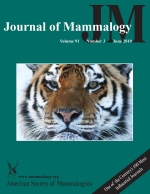Spatial dynamics and frequency of interaction between mating individuals are difficult to observe in the wild, and linking behavioral and genetic mating systems is particularly challenging for nocturnal or otherwise cryptic mammals. We monitored 29 (11 male and 18 female) adult raccoons in northeastern Illinois to gain a better understanding of how individuals interacted with one another during the mating season (December–March) of 2005. Adults were monitored with proximity-detecting radiocollars to determine the amount of spatial overlap and rate of contact among members of the local population, including those parent pairs that had mated successfully. We identified successful matings by conducting parentage analyses on 43 juveniles using 15 highly variable microsatellite loci. We were unable to identify parents for 25 of 43 juveniles, which greatly reduced our ability to assess the raccoon mating system. However, we present novel data on contact rates and den-sharing incidents between known parental pairs. We found that 3 of 4 parent pairs shared >35% of their daytime resting areas and >26% of their core resting areas. Contact rates of parent pairs varied, ranging from 0.1 to 0.9 contacts/day. Parent pairs were not observed to share dens during the mating season. However, among the remainder of the adult population, we found a sharp increase in instances of den sharing between unrelated adults that coincided with the peak of the mating season. Finally, male coalitions were not successful at sequestering breeding access to reproductive females; only 38.8% of juveniles were sired by males known to live in groups.
How to translate text using browser tools
16 June 2010
Behavioral and genetic aspects of the raccoon mating system
Stephanie A. Hauver,
Stanley D. Gehrt,
Suzanne Prange,
Jean Dubach
ACCESS THE FULL ARTICLE

Journal of Mammalogy
Vol. 91 • No. 3
June 2010
Vol. 91 • No. 3
June 2010
CERVUS
contact rates
den sharing
mating strategy
multiple paternity
raccoons
social behavior




